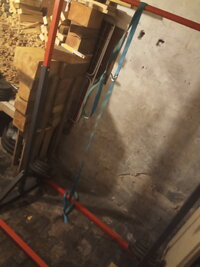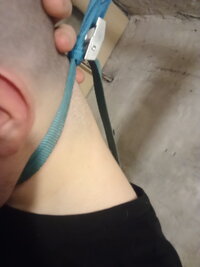H
hell toupee
Experienced
- Sep 9, 2024
- 298
Not sure if this will be helpful to anyone - it's kind of a summary of this gigantic thread, and my observations.
1) If you are attempting partial and not losing consciousness within 20 sec/or getting that exploding head feeling/or can't breathe/etc., ABORT. You are not doing it correctly.
2) From most people's experience with partial, you will need to experiment and find the best placement of the knot and rope. Most people seem to have more success with above the Adam's Apple, while others have reported that below the AA is best. Knot placement, IMO, should be to the left - this takes pressure off of the trachea and (hopefully) compresses the right carotid artery. Again, you will need to experiment - you will know when you have hit the carotid as it comes on pretty quick (blacking out) and feels pleasurable by most accounts (ie auto erotic asphyxiation).
Again, if you go more than 20 seconds and your vision isn't fading/you can't breathe/SI kicks in, you need to stop, take a break, and readjust.
3) People wonder how so many people, for thousands of years, have used hanging to die. At a glance it appears very easy. Indeed, the Japanese suicide manual posted last week stated that hanging is the best, most lethal, and least painful method - "people who want to commit suicide need to burn it in to their brains that hanging is the easiest method (other than maybe a gunshot). Furthermore, MOST of the people dying in this manner are using full suspension. I realize that full suspension is a lot scarier because you can't back out and nobody want's to be panicking and suffocating. I believe this is a double edge sword. In order to truly cut off the carotids quickly (which is what we are all after) - full suspension seems to be the only way to guarantee that.
4) Partial is doable, but takes a lot of trial and error - unless you get lucky, which some people do. I would not "practice" until you are truly ready to ctb - it's certainly possible that you go to test, get lucky, pass out right away and die. Personally, what worries me about partial is the fact that unconscious movements could loosen the knot or even a tiny bit of pressure and restore at least some blood flow to the brain - it's a big risk of it not working, imo, There are more than a few reports in here of people blacking out with partial, and then waking back up a little later - remember, partial relies on occlusion of the carotids in specific positions - the slightest of adjustments could restore some type of blood flow to the brain - enough to keep you alive, but perhaps not enough to prevent brain damage. It should also be mentioned that in the 1st study mentioned below with the 8 partial hangings, in all instances the deceased were witnessed as extending their legs and arms, then retracting them, while they were unconscious. There are more than a few reports in this thread of people blacking out with partial and then mysteriously standing up - this seems to be the reason why. Given that partial relies on this delicate balance of pressure in the right spot, the more I think about it, the more danger of something going wrong it seems, with partial.
5) There are several studies mentioned in the thread. One was about a team of scientists who studied 8 videotaped partial hangings (both suicide and accidental auto erotic asp. deaths). In 6 of those cases consciousness was lost in 8-18 seconds. The other 2 cases they could not determine loss of consciousness because the person had a bag/mask over their head. I think a safe guess here is that those other 2 DID in fact lose consciousness quickly, because there is no mention in the study of those 2 people thrashing about and panicking - which is what I would expect if they were still conscious. So basically, you have 8 people who lost consciousness very quickly,
6) The 2nd study, which I find more interesting was done during WW2 to study why pilots lose consciousness on rapid ascents after bombing runs. This was done by a fellow named Rossen, which you can look up. They built an improvised blood pressure cuff, put it around the neck of 58 volunteers, and all lost consciousness within 5-15 seconds. It was called a "KRA Cuff". As you can see in the pic, a bladder, like on a blood pressure cuff, is inflated to block ONLY THE SIDES of the neck. There is a huge space in the front so breathing is not interrupted and it doesn't feel like your windpipe is being crushed. This device, to my eyes, basically represents a blood choke in Jujitsu/Judo/MMA/etc - where the forearms are compressing the carotids and the windpipe is basically untouched. If you watch fighting/martial arts - there is very rarely any panic when someone is choked unconscious - and these are guys that are breathing really heavy while being choked. If they were suffocating, or even coming close to it, there would be a lot of panic.
This is just a thought, but perhaps an analog (not digital as they have auto release) blood pressure cuff could be used, except you place an object from your chin to the lower part of the neck so the cuff only compresses the sides - a small piece of wood, or something of that nature - just thinking off of the top of my head here.
Here is the KRA Cuff so you can get an idea of where the pressure is being placed and what you are attempting to replicate. If using a rope, it almost looks like it would be better to not tie a knot and hang full suspension with a simple loop - (like how someone puts a towel over their shoulders but instead of a towel and the ends hanging down, they would be secured to the anchor. In that case your face would be towards the wall - not away from it. Hanging full suspension like that would place zero pressure on windpipe, and be directed to the sides of the neck instead - there is a picture somewhere in this thread of a deceased hanging from a staircase exactly in this manner - using what looks like a bedsheet. He wrapped a half loop around the back of his neck, and hung full suspension facing the wall/stairs/anchor - so he was basically looking up when he died, not down. This puts all pressure on sides/back, not front. I have not tested this, I'm just speaking off the top of my head - just an idea is all, My first concern with this scenario though, is slipping out of it when myoclonic jerks start happening. Have to think about it a little more.
View attachment 177927


I will not comment on rope types/knots/anchor points as that kind of stuff is all over the thread. I will say if you need a cheap, quick, and easy anchor point, Partial Elf made the excellent suggestion 100 times for an exercise band holder that has a little ball on the end and slips over the top of your door. You close the door and the ball gives you a sturdy anchor point with a little loop on the other end that you would tie your rope to. They are $6 on Amazon and are designed to hold weight.
Part of the reason I want to ctb is I became crippled a little over a year ago - nerve damage in my fingers and toes. That put me in a wheelchair, and made my fingers ball up in to fists (except thumbs). If I had the dexterity in my fingers, I think it would be very doable to build a makeshift device like the KRA cuff above using a couple of blood pressure cuff bladders mounted or fixed to something that goes around your neck with an opening in the front. I say 2 bladders because using only 1 would involve having to loop it around your entire necks, With 2, which is what appears to be above, you could have 1 bladder for each side. The problem is finding something to mount it in/on (maybe something with a zipper? Like a pillow case cover that has been cut down to only be a few inches long?).
I don't know. Maybe if we put our heads (pun) together we can figure out a way to do this. 58 volunteers. Every last 1 lost consciousness immediately. People are choked in Jujitsu classes every day around the world. If we could figure out a way to mimick the above, it could be a fast, painless solution. Of primary importance would be makiing sure it doesn't slip out of place though.
EDIT: Was trying to think of ways to adapt the blood pressure cuff(s) idea in to some kind of mechanism that would go around the neck in a similar fashion to the above "KRA Cuff", and I'm wondering if one of those neck braces they use for people with broken necks could be adapted - or possibly those neck comforter/cushion things that people use on flights and stuff. There might be something in the medical equipment community of products that could be used.
At this point I'm just rambling though - I was hoping to spur some ideas but it seems there isn't much interest in this thread anymore.
EDIT #2: Since it's too late and I can't make edits anymore, there is something I want to emphasize.
A member here, I believe it was Partial Elf, was practicing trial and error with partial and not having any luck. However, he identifies an important component that started leading to consistent results.
That is, even when it's partial, most people seem to ease in to it, obviously trying to gauge how painful it will be. According to Partial Elf (apologies if this is the wrong member, there are so many posts ITT it's hard to keep track), he only started having success in compressing the carotid artery when he just kind of relaxed his body and dropped all of his weight in to one of the partial positions (not sure which) all at once.
I am obviously not a doctor, but what this tells me is that it's very possible that in order to completely pinch the carotid shut, it needs to be clamped down rather than slowly squeezed shut when you are easing in to it. I'm also not a physicist, but my guess is it's hard to slowly pinch the arteries shut because there is a certain amount of pressure going through there.
Think of a garden hose with water going through it pretty forcefully. To pinch the hose shut, it is much more feasible to quickly make a bend, or kink in the hose. If you just slowly try and squeeze the hose shut with your thumb and index finger it's going to be much more difficult.
Just a thought. Hope this helps.


